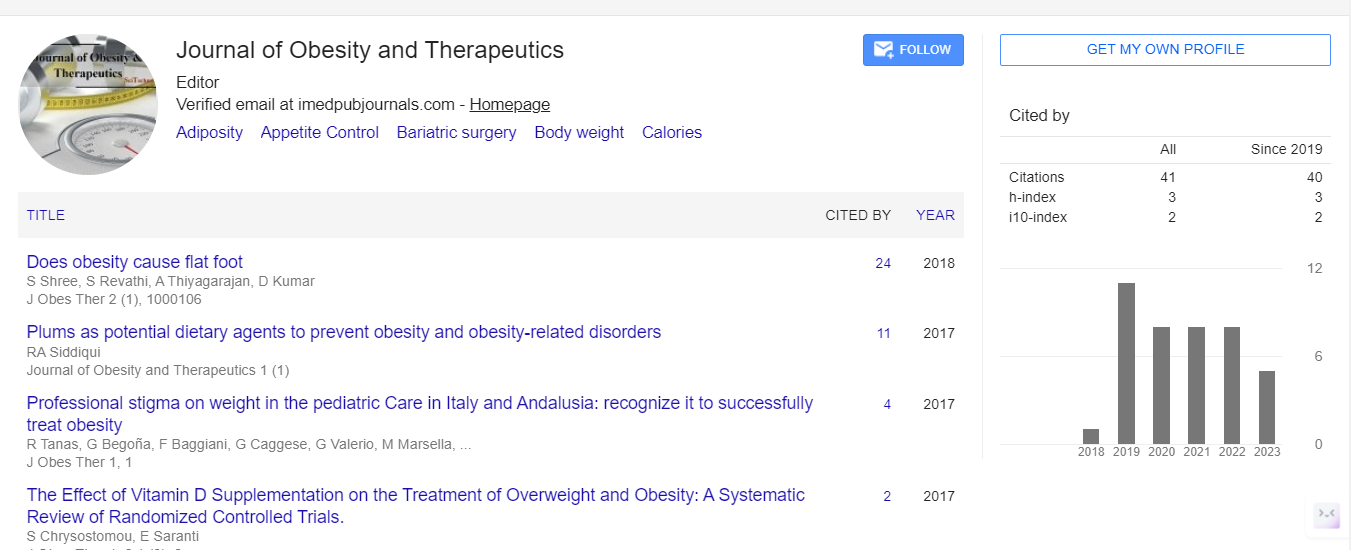Editorial, J Obes Ther Vol: 1 Issue: 1
Diet, Obesity and Intestinal Barrier
Jesmine Khan*
Sungai Buloh Campus, Universiti Teknologi MARA, Malaysia
*Corresponding Author : Jesmine Khan
Faculty of Medicine, Sungai Buloh Campus, Universiti Teknologi MARA, 47000 Selangor, Malaysia
Tel: +603-6126-7364
E-mail: jesminek@salam.uitm.edu.my
Received: June 16, 2017 Accepted: June 19, 2017 Published: June 26, 2017
Citation: Khan J (2017) Diet, Obesity and Intestinal Barrier. J Obes Ther 1:1
Abstract
Well-known function of the gastrointestinal tract (GIT) is digestion and absorption of food. A healthy GIT is essential for the proper digestion, absorption and utilization of food. Improper digestion and absorption of food leads to malabsorption, diarrhea, malnutrition and deficiencies of various nutrients. Another important yet less known function of the GIT especially the intestinal tract is to act as a barrier known as the intestinal barrier (IB). IB is formed and strengthened by several constituents which include microbial flora of the lumen of the GIT, mucus blanket produced by the secretion of goblet cells, villi, crypts, Peyer’s patches, tight junction proteins situated in between the enterocytes of villi and follicle associated epithelium of Peyer’s patches and the other layers of the GI wall.
Keywords: Diet, Obesity and Intestinal Barrier
Well-known function of the gastrointestinal tract (GIT) is digestion and absorption of food. A healthy GIT is essential for the proper digestion, absorption and utilization of food. Improper digestion and absorption of food leads to malabsorption, diarrhea, malnutrition and deficiencies of various nutrients.
Another important yet less known function of the GIT especially the intestinal tract is to act as a barrier known as the intestinal barrier (IB). IB is formed and strengthened by several constituents which include microbial flora of the lumen of the GIT, mucus blanket produced by the secretion of goblet cells, villi, crypts, Peyer’s patches, tight junction proteins situated in between the enterocytes of villi and follicle associated epithelium of Peyer’s patches and the other layers of the GI wall. IB acts as a barrier between the content of the GI lumen and systemic circulation thus prevents the entry of different macromolecules and antigenic materials from the intestinal lumen into the systemic circulation. Disruption of any of the layers of the IB might have several harmful effects within the body.
Several physiological and pathological factors such as ageing, stress, infections etc. has been reported to disrupt IB. Obesity in animal models caused higher small intestinal permeability of macromolecules by disrupting the components of IB. Diet especially high fat diet (HFD) induced obesity plays a significant role in the disruption of IB of small intestine [1]. Recently high carbohydrate diet induced obesity is also being blamed for altering the integrity and function of IB through dysbiosis i.e. alteration of the intestinal bacterial flora with overgrowth of harmful bacteria and destruction of beneficial bacteria [2].
Obesity is associated with chronic low grade inflammation throughout the body [3]. HFD induced obesity in animal model was associated with higher level of intestinal inflammatory marker e.g. fecal calprotectin level and with reduced expression of TJPs of the villi and PP, which are important components of IB [4]. Due to disruption of the TJPs of the follicle associated epithelium of PP, there was increased transport of antigenic materials through the PP in obesity [5]. Excessive transport and subsequent processing of molecules into the PP has the potential to exacerbate unwanted immune responses within the body. Disruption of the TJPs of villi increased the intestinal permeability of macromolecules from the intestinal lumen. Due to the ongoing inflammation in obesity, it is very much possible that other components of the IB could also be destroyed. Various group of researchers has agreed that obesity induced metabolic complications in animal models is associated with disruption of IB function. But unfortunately very few data exist in human being. It is high time for transforming the findings of animal studies in human being. Welldesigned randomized controlled trials in human being are necessary to investigate whether IB function is altered in obese subjects to identify modulating agents to combat such changes.
References
- Cani PD, Possemiers S, Wiele VDT, Guiot Y, Everard A, et al. (2009) Changes in gut microbiota control inflammation in obese mice through a mechanism involving GLP-2-driven improvement of gut permeability. Gut 58: 1091-1103.
- Rosa KB, Zehra-Esra IDWK, John K, Baise D (2012) Effects of gut microbes on nutrient absorption and energy regulation. Nutr Clin Pract 27: 201–214.
- Hansongyi L, Seok IL, Choue R (2013) Obesity, Inflammation and Diet. Pediatr Gastroenterol Hepatol Nutr 16: 143–152.
- Auni AZA, Effat O, Islam MN, Khan J (2015) High Fat Diet Alters the Expression of M Cells and Claudin 4 in the Peyer’s Patches of Rats. AJCEM 3: 283-287.
- Khan J, Mohamad M, Froemming GRA, Islam MN (2013) High fat diet increases uptake of particles by the Peyer’s patches of ileum in rats. IMJ 20: 232-234.
 Spanish
Spanish  Chinese
Chinese  Russian
Russian  German
German  French
French  Japanese
Japanese  Portuguese
Portuguese  Hindi
Hindi 